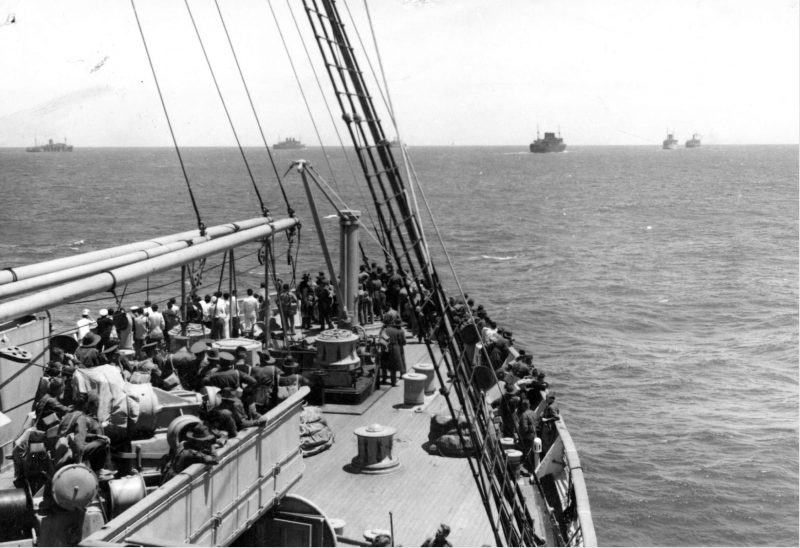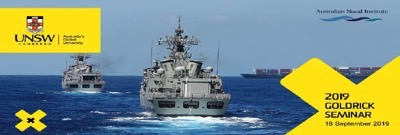
By Vice Admiral Peter Jones AO DSC RAN Retired

From the early days of the European settlement until the first years of the 20th Century, there has been concern in Australia about the interdiction of shipping bound to and from Australia. The threats changed over time from France, Russia, Germany and then Japan. Indeed the need to protect trade and keep our ports open was a major driver for the birth of Colonial navies, the maintenance of the British Squadron on the Australian Station and then the birth of the Royal Australian Navy (RAN). While some of the concerns, such as in the case of Imperial Russia was somewhat alarmist, in the case of Germany and Japan it was well founded.
World War I
At the outbreak of the First World War the RAN’s priority was to neutralize the threat to merchant shipping and Australian ports by the German East Asian Squadron. In particular the possible use of Rabaul as a base for operations against merchant shipping and troop convoys was scene as a threat to be neutralized. Within a year the RAN’s relatively powerful Fleet, centred around the battle cruiser HMAS Australia had captured Rabaul, deterred Admiral von Spee from Pacific Ocean operations and sunk the lone raider the SMS Emden.
The main threat was therefore surface ships, but in the second half of the war our torpedo boat destroyers did operate against Austrian submarines and surface ships attempting to interdict shipping in the Adriatic and Mediterranean. In some theatres such as in the north Atlantic techniques such as convoys and early anti-submarine detection and destruction systems were employed. But the RAN had limited exposure to these innovations.
It is worthwhile to discuss the logic of convoying. Essentially convoying is a response to the laws of probability. Convoys concentrate merchant ships so there are fewer parts of the ocean in which they can be found by an adversary. The escorts are also concentrated with the convoy and so if the convoy is detected then it has hopefully sufficient protection. While appearing an anachronism today to some, in the right circumstances the tactic is still relevant.
In World War I therefore the RAN had successfully protected merchant shipping which was vital for trade, troop movements and sustainment. Importantly, this effort was part of a global Allied effort orchestrated in large part by the Admiralty.
The Interwar Period
In the interwar period despite a paucity of funds there were important developments in the field of trade protection. In 1923 the RAN sent two officers, Lieutenants James Esdaile and Harry Melville to undertake just the fourth of the Royal Navy’s new Anti-Submarine specialist courses. Esdaile stayed on at HMS Ospreythe Anti-Submarine School and took part in trials on submarine detection systems. He then was sent to Navy Office in Melbourne to develop the Navy’s anti-submarine capabilities. Esdaile and others, combined with the intellectual and technical leadership of the RN, developed a comprehensive plan to counter the submarine threat.
In 1925 the British Committee for Imperial Defence wrote an influential paper titled, Requirements for minesweeping and Auxiliary anti-submarine vessels at various Empire ports in the event of war in the East. By the late twenties the RAN had developed a three pronged approach:
- Key ports would have boom defences, a series of indicator loops on the harbour bottom as well as Asdic (later called sonar) on smaller warships and auxiliaries. Destruction would be achieved by depth charges.
- In the approaches to the ports and along the coast corvettes, sloops, corvettes and auxiliaries would protect the vital coastal shipping.
- Offshore, cruisers and destroyers would be fitted with sonar and depth charges. Of note the first sonar to go to sea was in the cruiser HMAS Sydney.
At the same time similar plans were put in place to deal with mines laid by submarines and surface raiders. It is not always appreciated that one of the key missions for the Navy’s cruisers was to counter the threat of commerce raiders be they conventional warship or raider.
World War II
During World War II our merchant shipping came under attack first from Germany and then Japan. Germany commenced a trade war involving pocket battleships, cruisers, auxiliary cruisers ( most notably the Kormoran which sank the Sydney) and submarines. It is not well known that the U-862operated off the Australian and New Zealand coasts.
Most challenging was the raider threat. The RAN assigned a cruiser on each coast to help deal with this unpredictable foe. Typically, one only knew where a raider had been in the open ocean by a merchant ship’s distress call.
Significantly, this threat led to the creation of the first Combined Operational Intelligence Centre to bring the services resources together to effectively counter the raiders. By the end of the campaign the Germans would sink over 30 ships and significantly disrupt trade. Intelligence was of critical importance to protecting. The breaking of German codes enabled merchant ships to be routed wherever possible through areas where the submarines were not. The routing or Naval Control of Shipping would remain an important tool in the post-war period.
For their part the Japanese attacks on trade were mainly from submarines. There was however occasional surface ship forays and of course air attacks in South East Asian and SW Pacific waters. Japanese submarines operated as far as South Australia. The effectiveness of these forays was mitigated in part by the poor quality of Japanese mines. Their most notable action was their attack on Sydney Harbour. The Sydney defences, conceived in the late 1920s, while still not fully installed were sufficient, with a dose of luck, to counter the midget submarine attack.
As in World War II convoying was to prove very effective. Not just in the Atlantic but in the Australia station and the Pacific where it was applied. To give a feel for this local effort over 250 convoys were staged on the Australian east coast.
As their performance and range increased aircraft became a major weapon in the protection of trade. Both land based and ship based aircraft could detect, suppress and engage both air, surface and sub-surface threats to shipping.
Cold War
In the Cold War Australia and her Allies were energized by the growing and potent Russian submarine threat. Her submarines were fast and armed both with torpedoes, mines and anti-ship missiles. This posed both an underwater and above water threat for merchant shipping and escorts. The Russian challenge of quiet and fast submarines as well as a growing array of missile armed aircraft and ships forced Western navies to respond with specialist anti-submarine and anti-air escorts.
During the 1960s and 70s the Australia directed considerable resources to these threats and the indigenous Ikara anti-submarine missile, the Mulloka sonar and the Barra sonobuoy were shining examples of this effort.
As the submarine became more lethal with longer range missiles and torpedoes the importance of shipborne helicopter and maritime patrol aircraft grew. Escorts and merchant ships needed to be kept at arms length from a submarine. This imperative was aided by such developments a passive and active towed arrays which could detect submarines at longer range.
The Modern Era
In the post Cold War era the Australian Defence Force has been involved in trade protection operations, often in a low profile role. I offer just a few examples. In the lead up to the 2003 Iraq War the RAN Task Group and P-3C were involved in escorting shipping in the central and northern Arabian Gulf. In this operation focal points were patrolled and some high value ships were individually escorted.
Subsequent to the Iraq conflict the RAN and RAAF have been involved in the protection of trade from piracy off the Horn of Africa. Now of course the new mission looms for the protection of shipping through the Straits of Hormuz.
So to conclude this historical survey, what can we glean that is relevant today.
First, trade protection has been an abiding mission for the Australian Defence Force, but one that sometimes get pushed into the background by particular events. Second trade protection requires a suite of measures both at sea and ashore to counter air, surface, subsurface and terrorist threats not to mention piracy. And finally, It requires skills in areas such as anti-submarine and anti-air warfare that take much time to develop but ones that can be easily lost.
This paper was presented at the 2019 ANI Goldrick Seminar



